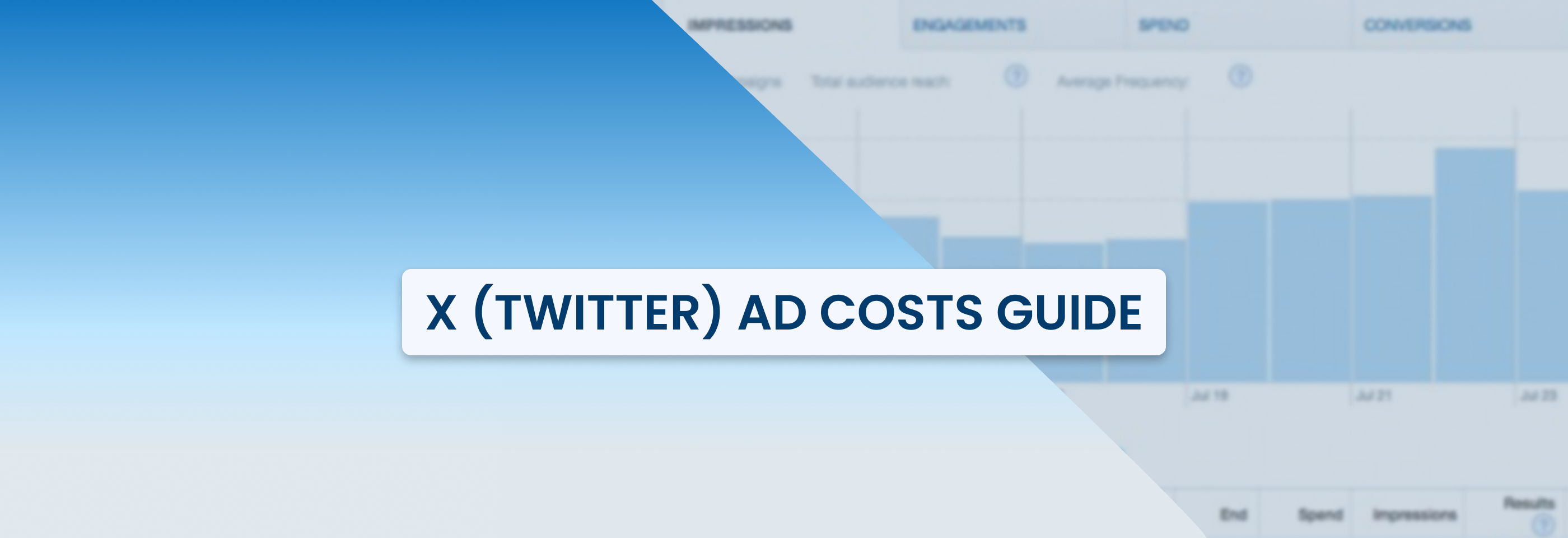How to Optimize Facebook Ads for Better Results in 2025
2025-01-10
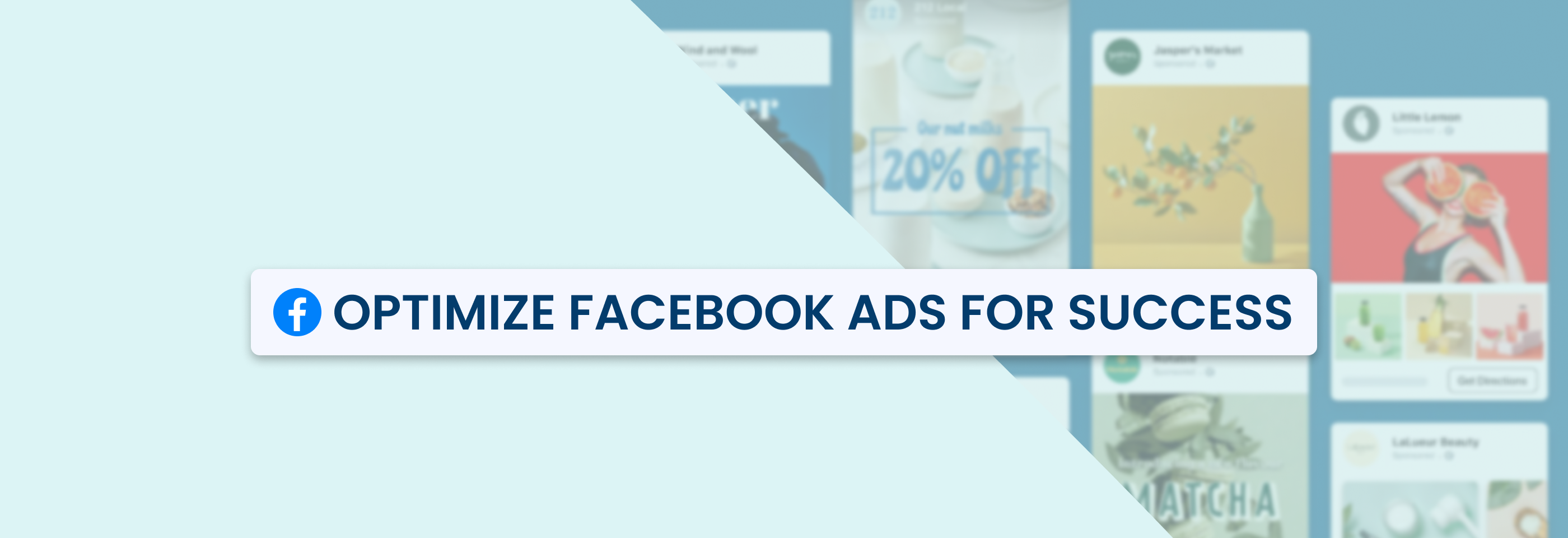
The start of a new year is more than just turning the calendar – it’s the perfect chance to reset, refocus, and elevate your Facebook ad campaigns.
Facebook ads are a powerful way to reach customers, get your brand noticed, and drive more sales. The key lies in how you optimize your Facebook ads to deliver results that count, and the best time to do it is the beginning of the new year.
In this guide, we’ll show how to set your Facebook ads for success right from the start in 2025 using the best strategies and tools. How to optimize your Facebook ads for 2025
Step 1: Reflect on last year’s campaigns
Before jumping into new campaigns, take a moment to reflect on your Facebook ads from 2024. Understanding what worked and what didn’t is the first step to improving your ads in 2025.
First, you need to review your campaign performance data in your Meta Ads Manager. Take a look at the key metrics and indicators that tell you how effective your Facebook ads were:
- Return on Ad Spend (ROAS): ROAS shows how much revenue you made for every dollar you spent on ads. If it’s low, your targeting wasn’t exactly on point, your ad creatives weren’t working for your audience, or your offers could have been more attractive. The place where the checkout happens (e.g. your website) might also be the reason for a low ROAS.
- Click-Through Rate (CTR): CTR tells you how often people clicked on your ad after seeing it. A low CTR might mean your ad wasn’t catching your audience’s attention because of your visuals, headlines, or copy – they weren’t clear, exciting, or relevant enough.
- Engagement rate: engagement rates measure likes, comments, shares, and other interactions with your ad. Low engagement could mean your ad didn’t resonate emotionally or visually.
- High costs: if some of your campaigns or ads had higher costs per click or conversion, you were likely targeting a very competitive audience and showing your ads on expensive ad placements, or your ad creatives weren’t that effective.
- Unresponsive audiences: if you noticed that some audience segments didn’t interact with your ads, it might mean your product was not the right fit for them or the ad’s messaging was off.
Once you’ve reviewed the initial data, dig a little deeper, break down the results, and summarize your insights – you’ll put them in action when planning your 2025 campaigns.
Which campaigns or ads didn’t end up delivering the results you were hoping for? Figure out what went wrong and how you can avoid it in the upcoming year. What worked well? Spot the campaigns that performed the best.
Did a specific ad format work better than others? Was a certain type of messaging more effective? Were specific audience segments more active than others? These are your winners, and they might bring you good results in 2025 as well.
You can also check if certain campaigns performed better at specific times of the year. Certain industries, like e-commerce, see spikes during holidays or before the start of a new season – reviewing these periods can help fine-tune timing for 2025 campaigns.
Step 2: Update your goals for the new year
With insights from your last year’s campaign review fresh in mind, the next step is setting the right goals for the new year. Your 2025 Facebook ad strategy should align directly with your business objectives while also building on what you’ve learned.
Ask yourself: what is the main focus for my business this year?
Your Facebook ad campaigns should complement and support these larger priorities. Here are a few examples of what these strategies might look like and how they translate into Facebook ad objectives:
- Boost sales or sign-ups: focus on sales campaigns to drive actions like purchases or form submissions. The best course of action here is creating irresistible offers, like discounts or free trials, to increase urgency.
- Increase brand awareness: use awareness and engagement campaigns to expose your business to new audiences and grow recognition. Here, you want to show your unique value with bold visuals or engaging storytelling.
- Find new leads: run lead ads to expand your potential customer base. Offer gated content (like eBooks or discounts) as an incentive to share contact info.
- Retain customers: use retargeting campaigns to re-engage previous buyers with special offers or product updates.
Understanding your objective will help you set smaller goals that are also SMART:
- Specific: what exactly do you want to achieve? For example, instead of something vague like “increase sales,” aim for “increase retargeting conversions by 30% by March”.
- Measurable: track progress using metrics like click-through rates (CTR), conversion rates, cost per action (CPA), or return on ad spend (ROAS). Achievable: base your goals on past data but push yourself to improve.
- Relevant: make sure that your goals align with your broader business strategy and audience needs.
- Time-bound: set deadlines, e.g. achieving a 20% increase in conversions by the end of Q1.
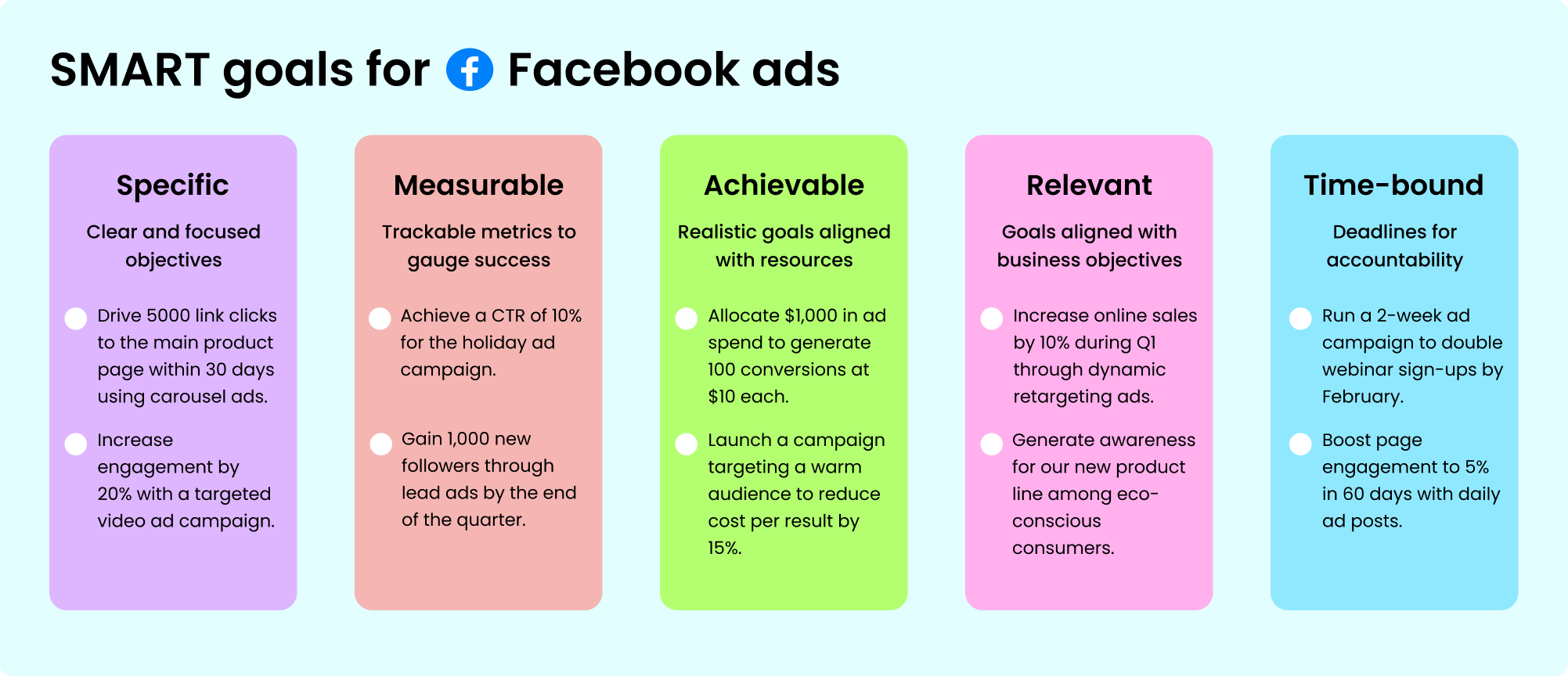
Also, plan for the year ahead by starting with a clear roadmap for your campaigns. For example, you could set a goal to build momentum with brand awareness campaigns from January through February, retarget engaged users and convert them into customers in March, and try new ad formats, creatives, or audiences to scale your campaigns in Q2 and beyond.
Step 3: Optimize your creatives
With your goals in mind and last year’s lessons learned, it’s time to give your Facebook ads a fresh look for 2025. Your audience probably wants to see something new, so don’t just recycle old visuals and messaging – try something new and more timely.
Bring in new themes that resonate
Think about how your messaging can align with the season and your audience’s mindset in the Q1. The start of the year is a time for optimism, resolutions, and fresh starts.
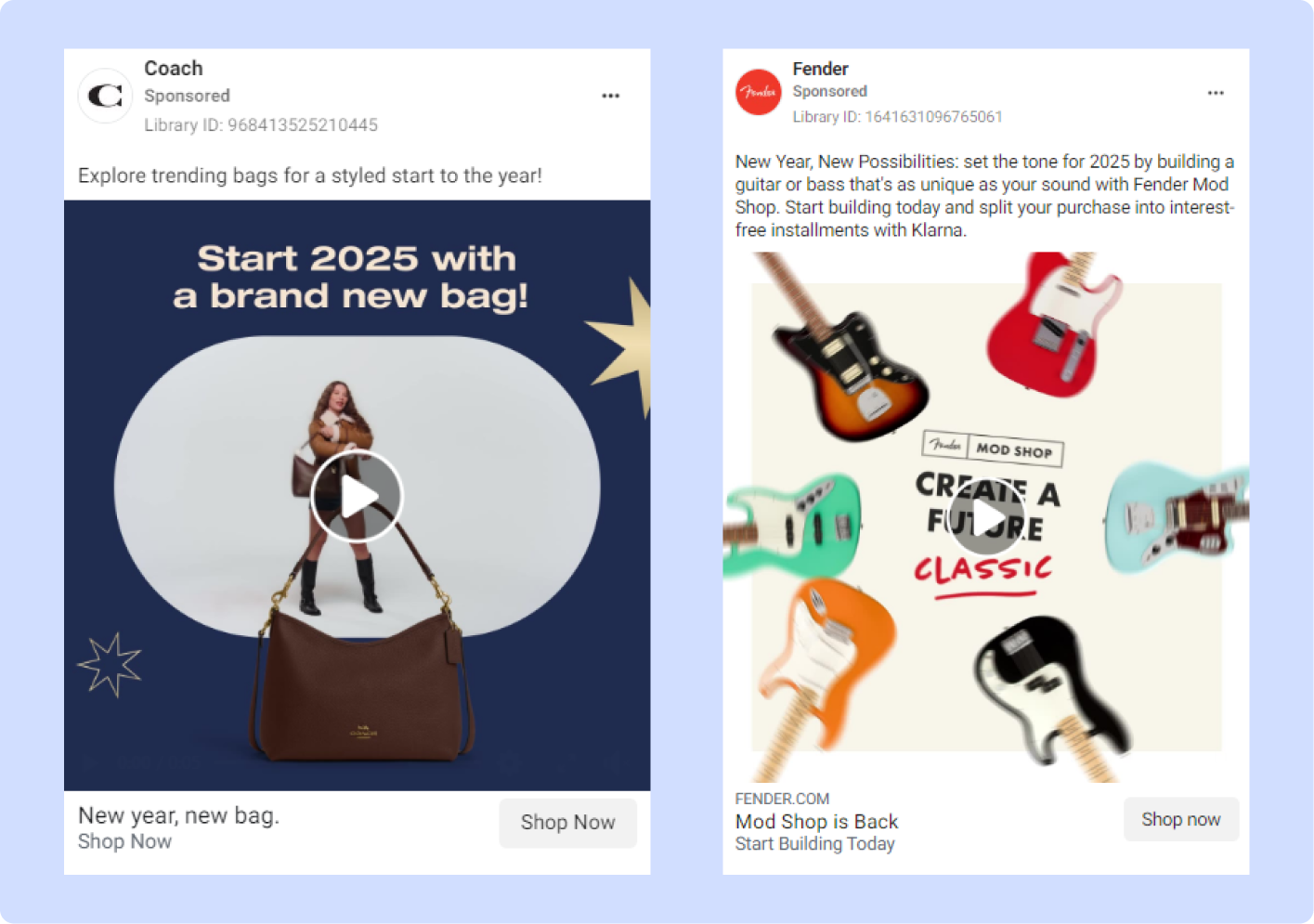
You can try themes like “new beginnings” or “achieve your goals” to tap into this energy – just make sure that your creative feels like a natural fit for where your audience is emotionally.
Level up your visuals and formats
Let’s face it: it’s difficult to attract and retain people's attention on most social media platforms, especially Facebook. That’s why this year, you need strong, eye-catching ad designs – you want to let your customers know why your business should be their go-to when they need a product or service like the ones you offer.
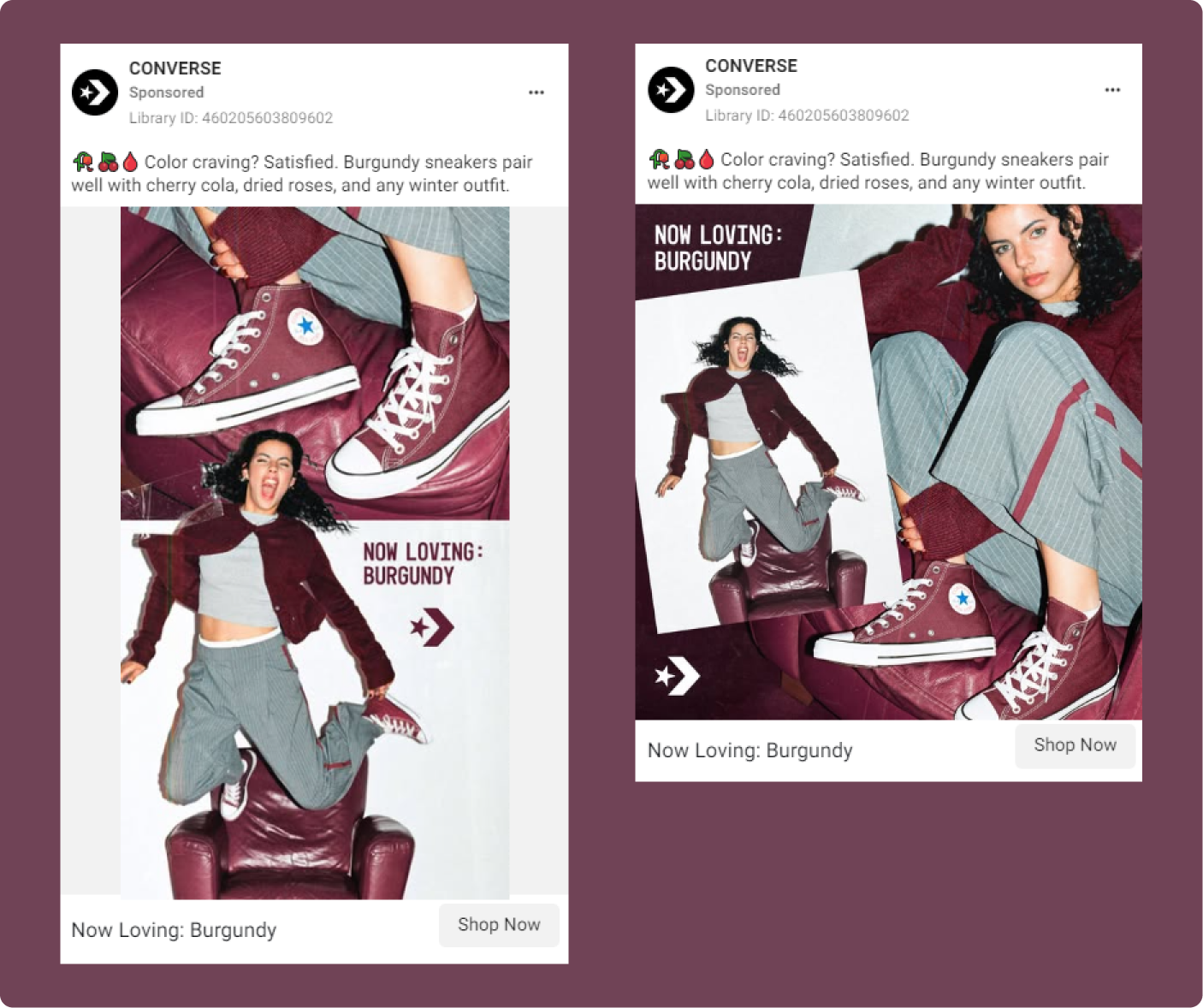 Follow Converse's example and try various formats and sizes for your Facebook ads - that's how you keep ad fatigue at bay.
Follow Converse's example and try various formats and sizes for your Facebook ads - that's how you keep ad fatigue at bay.
Q1 is the perfect time to explore Facebook ad formats that have proven to be effective for many advertisers. Here are some of them:
- Short-form videos: quick and engaging videos under 15 seconds grab attention like no other ad format. You can use bold visuals, engaging transitions, and clear messaging to hook your audience within the first few seconds. Adding text overlays or music will make them stand out even more.
- Carousel ads: this format is perfect for showing multiple products or telling a story in a swipeable format. Highlight product features, show off your best sellers, or walk users through a process step by step. Read how to create effective Facebook carousel ads for better results.
- Interactive content: polls, quizzes, or interesting questions can get your audience involved and provide you with valuable feedback.
Trying different ad formats and creatives can help your Facebook ads get noticed and deliver better ROI throughout the whole year. By doing this, you also figure out what your audience likes the most.
Match your creatives to campaign goals
When optimizing your Facebook ad creatives, focus on what you want to achieve, and let that guide your approach. Different goals (aka objectives) call for different strategies. Here’s how to handle the most common ones:
- Spreading the word about your brand (awareness): make sure people notice and remember you. Use bold images or videos that are true to your brand. Share your story and what makes your business special. Customer reviews and behind-the-scenes glimpses can also make your brand feel more real and trustworthy.
- Getting people to take action (sales): if you want people to buy something, sign up, or take another step, show them why your product is worth it right away. Highlight the benefits, use clear CTAs, and add some special offers like discounts or free shipping.
- Finding new customers (leads): to get people to share their contact info, offer something valuable — a free guide, a discount code, or early access. Add urgency with phrases like “Only Available for a Limited Time” and add matching CTAs to drive the point across.
- Driving more visits to your website or app (traffic): focus on clickable ads with clear headlines and a good reason to click. Show people what they can get after clicking — exclusive content, exciting deals, or helpful tools.
- Getting more app installs (app promotion): show how your app solves problems or makes life easier – use short videos to demonstrate key features or show real users benefiting from it. Offer perks like freemiums or free trials to encourage downloads.
- Boosting interaction (engagement): create ads that invite participation — ask questions, run polls or quizzes, share exciting sneak peeks, and use CTAs that encourage interaction like "Tell us what you think!"
Keep in mind that you won’t be able to figure out the best ad formats and creatives for your campaigns right from the start — you have to test different options.
Experiment to find what works
Beginning of the year presents the opportunity for testing various formats and creatives and picking what to use throughout the year.
You can try different tones in your messaging (headlines, descriptions, CTAs): playful vs. inspirational, personalized vs. more general, humorous vs. professional. Each audience segment you’re targeting might need its own tone of voice, so pay attention to what different groups of users react to better.
Mix up your visuals with professional photos, user-generated content, animations, and other types of creatives — the variety can help you appeal to different groups of customers. Don’t forget to test different offers: try various types of discounts and deals, see which ones work for specific audience segments, and use these insights to improve campaign performance.
Remember that if you’re doing regular A/B testing, you should only test one ad element at a time. Each experiment will teach you more about what resonates with your audience — the key for scaling your ads in the future.
Step 4: Optimize your audience targeting
You can’t improve your Facebook ad performance in 2025 without working on your audience targeting — even the most engaging creatives will fall flat if they aren't reaching the right people. Facebook has some great tools to help you find your ideal audience, but to really unlock their potential, you need to use them the right way.
Start broad to find your core audience
Kick things off with broad targeting: this strategy gives Facebook's algorithm room to find the people who are most likely to engage with your ads. This approach can be beneficial no matter where you are in your current Facebook ads journey:
- If you’re a beginner, you might not know exactly who your ideal audience is yet. Broad targeting allows you to gather valuable data on who engages with your ads and what works best.
- If you already have a converting audience, there could still be untapped groups of people who might convert but aren’t yet on your radar. A broader approach helps uncover these hidden segments.
Over time, you can refine your targeting based on this data, pinpointing the segments that are most likely to take action. Along the way, you’ll also get insights into the different demographics, behaviors, and traits of your potential customers.
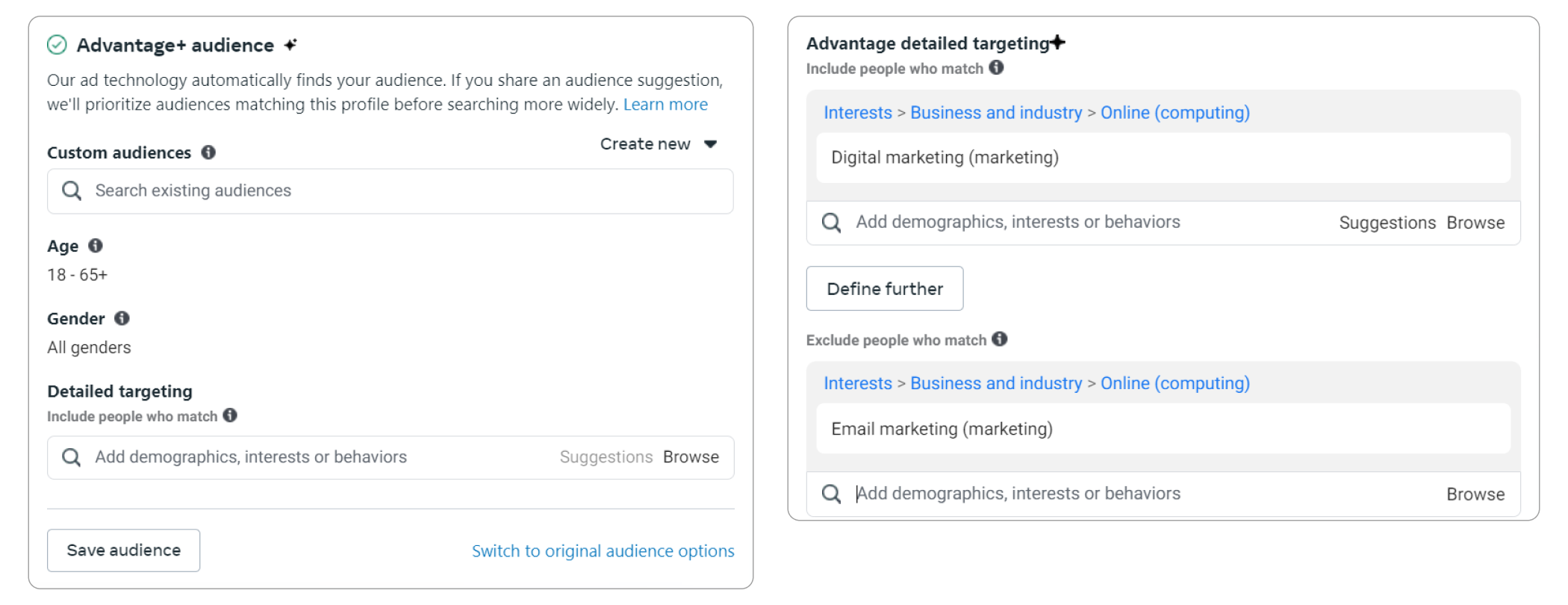 Meta offers several Advantage targeting options that can help you broaden your reach.
Meta offers several Advantage targeting options that can help you broaden your reach.
Here are some tips that will help you:
- Start with Meta’s Advantage+ targeting options: let Meta’s AI algorithms handle the hard work of finding the right people for your ads as they automatically adjust your targeting based on which audience segments are more likely to convert. Explore options like the Advantage Detailed targeting and Advantage+ Audience.
- Test multiple ad creatives: make several versions of your ads to appeal to different groups. Broad targeting works better when your ads connect with a variety of people.
- Monitor early results closely: look at metrics like clicks and audience details to see what’s working. This helps you find the groups worth focusing on as you refine your strategy.
After you’ve explored broader audiences, it’s time to focus on reconnecting with those who already know your business.
Re-engage with custom audiences
Once you’ve reached new audiences, don’t forget about the people who’ve already shown interest. Using custom audiences is the foolproof way to reconnect with users who’ve visited your site, engaged with your posts, or joined your email list.
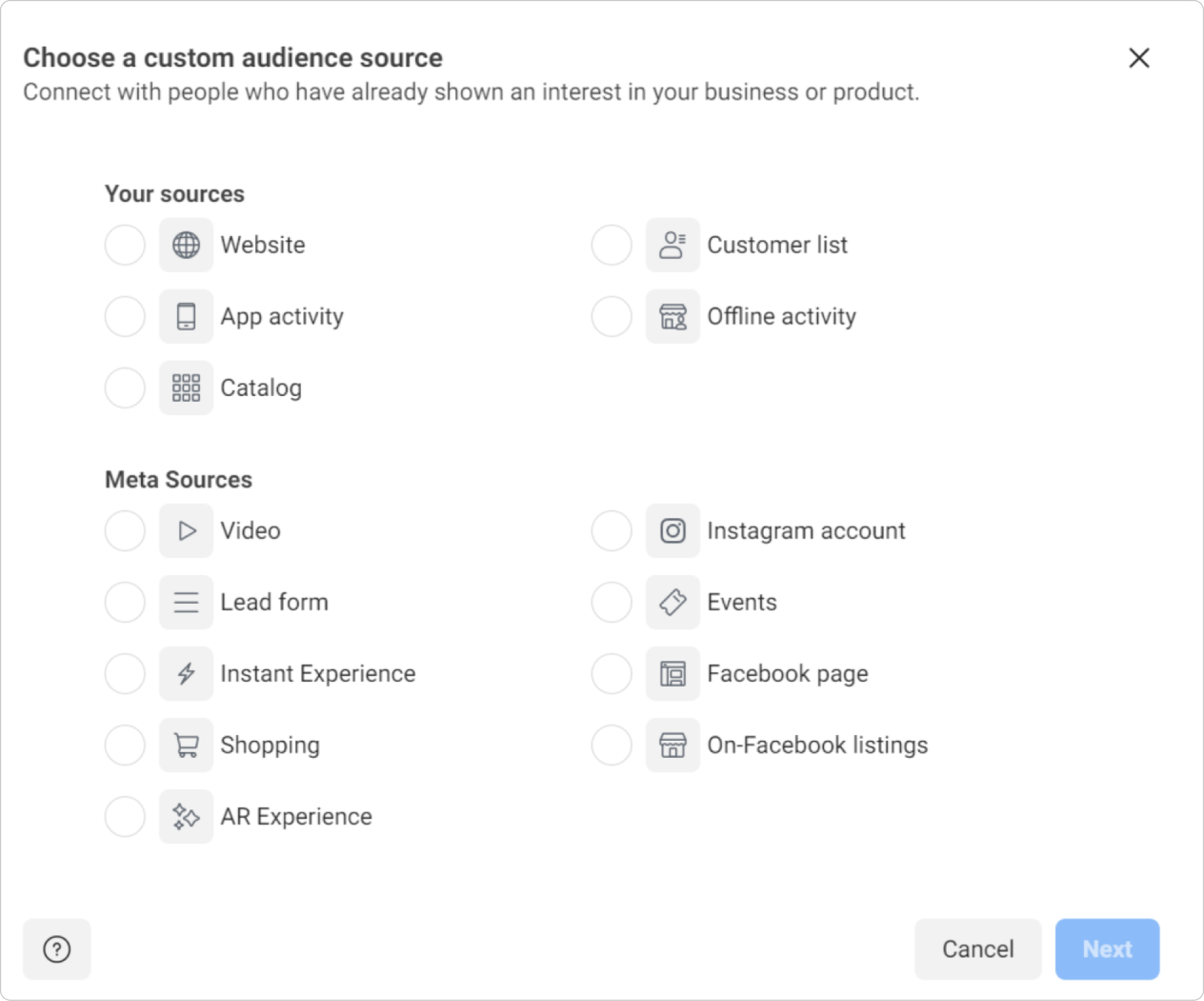
There are many ways to create a Facebook custom audience. If you want to reach more people, try Meta's Advantage Custom audience option.
That’s because these are warm leads — they know who you are and are more likely to convert. Here’s how you can use custom audiences effectively:
- Break your audience into groups: split your custom audience into smaller groups based on what they did – people who abandoned carts, just visited your site, etc. This way, you can run ads that feel more personal and specific to each group.
- Show products they already liked: use dynamic ads to automatically show people the exact products they looked at on your site. This reminder can help bring them back to finish what they started.
- Offer time-sensitive deals: create a sense of urgency by offering limited-time discounts or special deals. People are more likely to act when they know the offer won’t last forever.
- Share testimonials: include customer reviews or show how popular your products are. Seeing that others are buying or loving your products can help build trust and push people toward making a purchase.
Once you’ve reconnected with your warm leads, the next step is to reach more people like them.
Scale with lookalikes
Once you know your top customers, add lookalike audiences to your Facebook ad targeting strategy: these help you find more people who share similar behaviors, interests, and purchasing behavior. This is the best way to expand your reach while keeping ads relevant.
In the beginning of the new year, lookalikes might also be helpful for refreshing audiences for ads you’ve been continuously running – you can not just target people who already engage with your ads but find new similar segments.
Try these tactics to improve your Facebook ad performance with lookalikes:
- Use value-based lookalikes: focus on people who are similar to your best customers – those who make the most purchases or bring in the most revenue. This helps you find more people likely to spend and support your business. Test different audience sizes: start by targeting small lookalike audiences (1% match) and gradually increase the audience size (up to 10%). This lets you find the perfect balance between reaching new people and staying relevant.
- Combine lookalikes with retargeting: use lookalike audiences based on people who have interacted with your past ads or visited your website. This helps you reach new potential customers while still engaging those who’ve already shown interest.
- Leverage multiple sources for better results: combine different data sources (website visitors, email lists, and social media engagement) to create a stronger lookalike audience and increase the chances of finding more relevant people likely to convert.
Lookalike audiences can broaden your reach by a lot – use them when you need to freshen up your targeting or scale your ads.
Use first-party data
The shift from third-party cookies is already happening, and advertisers have to adapt to it before it’s too late. Here comes the first-party data collected from your own sources — email lists, CRM contacts, and website interactions — that is made up of people who have already expressed interest in your business.
Using this type of data is way more effective than relying on third-party sources: since you collect this data on your own, you can be sure in its quality and reliability.
Here’s how to use it effectively:
- Segment your data: don’t just look at your data all together. Split it into smaller groups based on what people do, what they’ve bought, or how they’ve engaged with you. This lets you create ads that speak directly to each group.
- Use website and app data: set up Facebook Pixel to gather data from people who’ve visited your site or used your app to understand their interests and what they’re looking for.
- Spot patterns in purchase behavior: look for patterns in what people are buying – which items they buy together, how often they purchase, etc. Use these insights to make better and more relevant ads.
- Link your CRM to Facebook ads: connect your email list or CRM to Facebook to build custom audiences. You can target people who’ve bought from you before or find new people who act like your best customers.
By combining these strategies, you’ll have everything you need to target the right people and maximize your Facebook ad performance in 2025.
Step 5: Automate your ad campaigns
If you want to run effective Facebook ads in 2025, automation is a must – this is key for managing and optimizing your campaigns for better results.
Here’s what you gain by automating your Facebook ads:
- Lower costs: automation makes your ads more effective, which means better results for less money.
- More time: automation tools handle time-consuming tasks so you can focus on strategy and planning.
- Faster scaling: automation helps you spot opportunities and improve ad performance quickly, all while minimizing human error.
Thanks to Meta’s Advantage+ tools, automation is now readily available to all Facebook advertisers. Here are the top options to try in 2025:
Advantage+ Placements
Maximizing your Facebook ad reach has never been easier thanks to Advantage+ Placements. This tool automates the entire ad placement process across all Meta platforms so you don’t need to manually select each platform. Instead of manually choosing platforms, your ads are automatically placed where they’re most likely to perform best. This means higher ROAS with less effort.
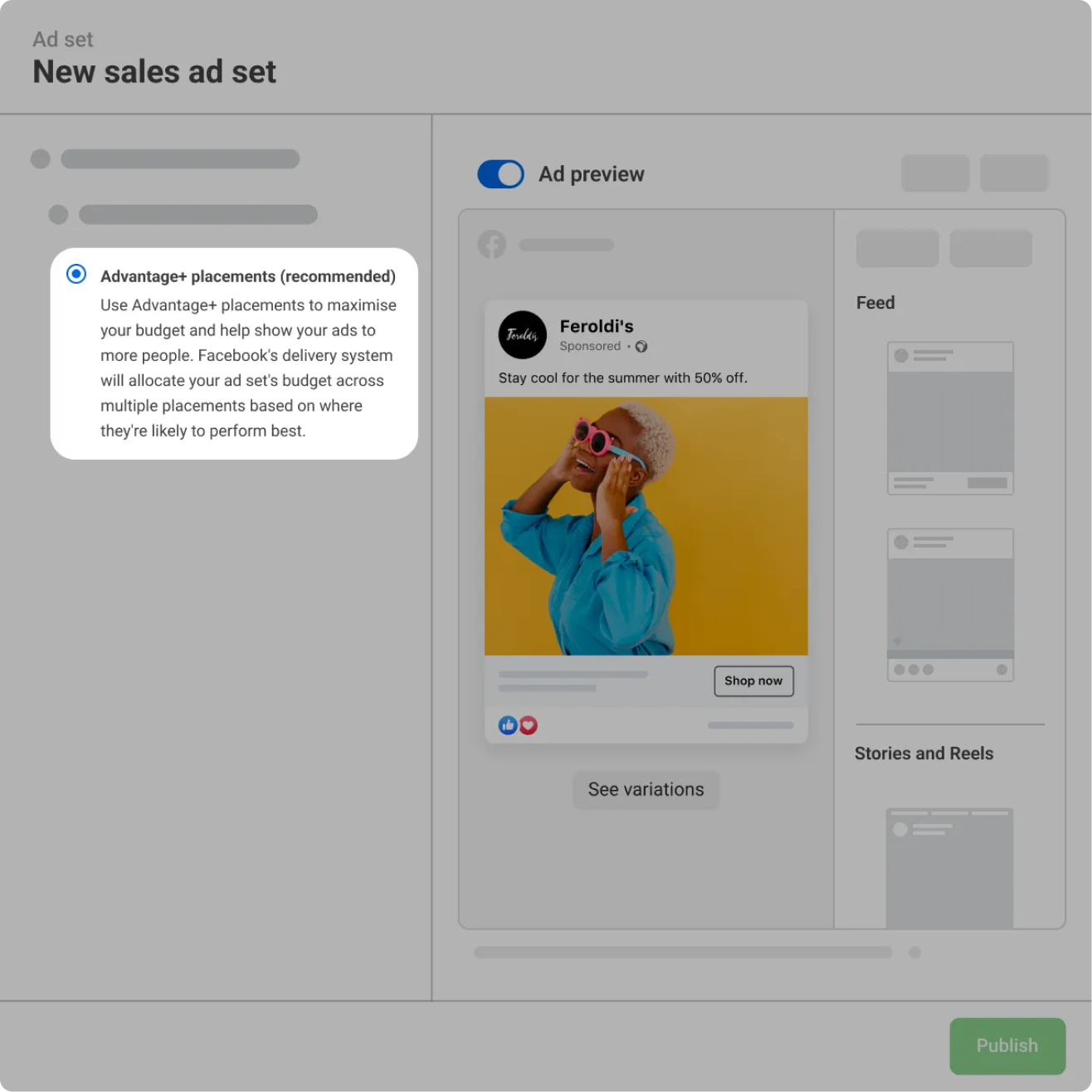
Advantage+ Placements option is ideal if you want to:
- Maximize your reach by showing ads across multiple placements.
- Test different audiences or expand into new, high-potential segments without micromanaging placements.
Advantage+ Creatives
Creating engaging ads is essential for success on Facebook, but wouldn’t it be great if you didn’t have to tweak your ad creatives manually? With Advantage+ Creative, Meta automatically tweaks your images, videos, and text to increase engagement and relevance.
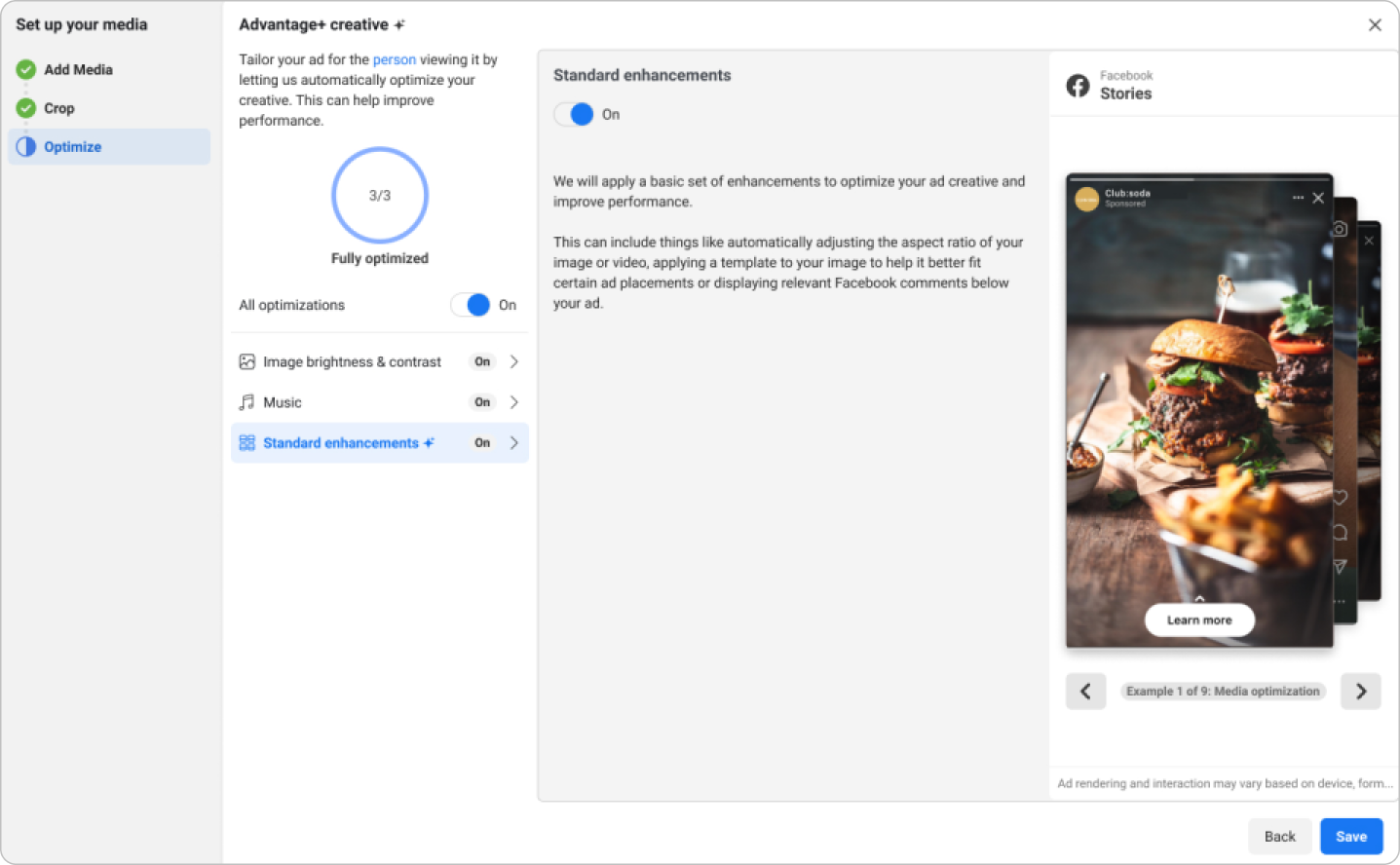
With Advantage+ Creatives, you can:
- Adjust brightness and contrast for visuals.
- Add music to static images or videos for platforms like Reels and Stories.
- Turn still images into dynamic videos with zoom and pan effects.
- Automatically adapt your creatives to fit different placements like Feed or Stories.
These tasks might seem simple enough, but tackling them manually for multiple ad creatives will take a lot of your time – it’s best to let Meta handle it for you.
Advantage Campaign Budget
Managing your Facebook ad budget manually can be a headache, that’s why you might want to use Meta’s Advantage Campaign Budget. With it, you can set one central campaign budget and Meta’s AI will automatically distribute it – more money will go to the highest-performing ad sets.
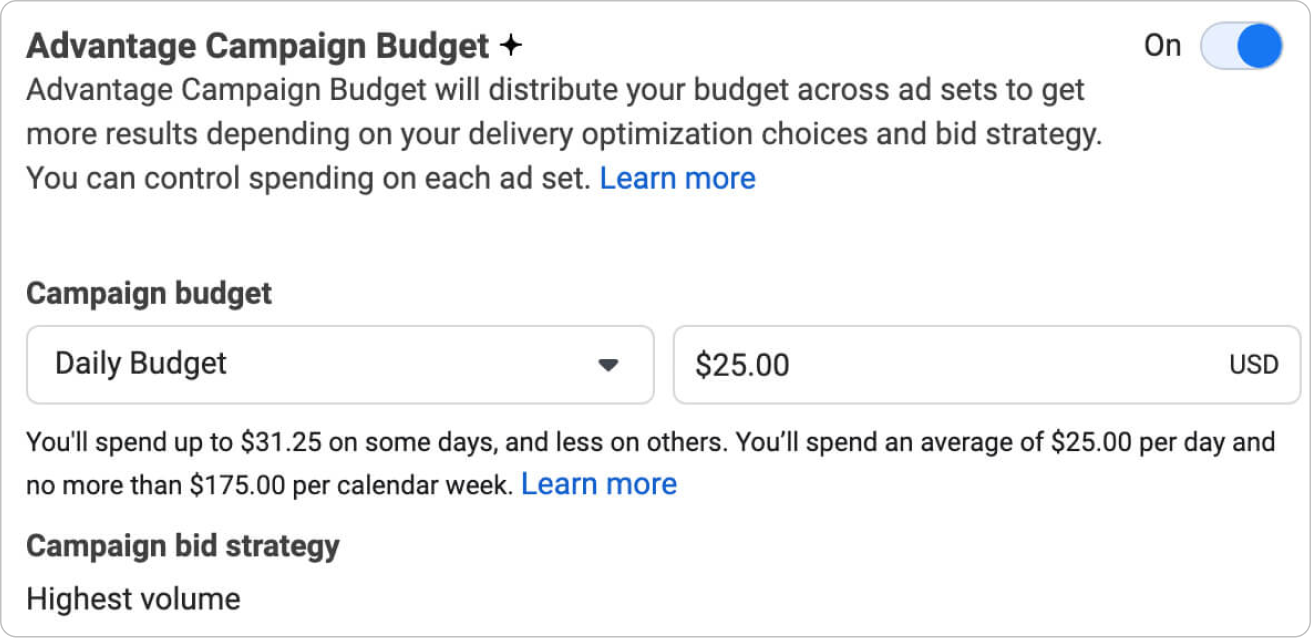
This is excellent if you have a lot of ad sets and you want to make the most out of your ad spend (especially when you’re looking to increase sales) – you won’t have to micromanage each ad set’s budget separately. Dive in into our explanation of what Meta Advantage Campaign Budget is all about for more details.
Automated Rules for more control
While Meta Advantage+ tools can handle placements, creatives, and budgets for you, automated rules give you more control. This feature lets you set specific triggers and actions based on your goals, combining flexibility with automation.
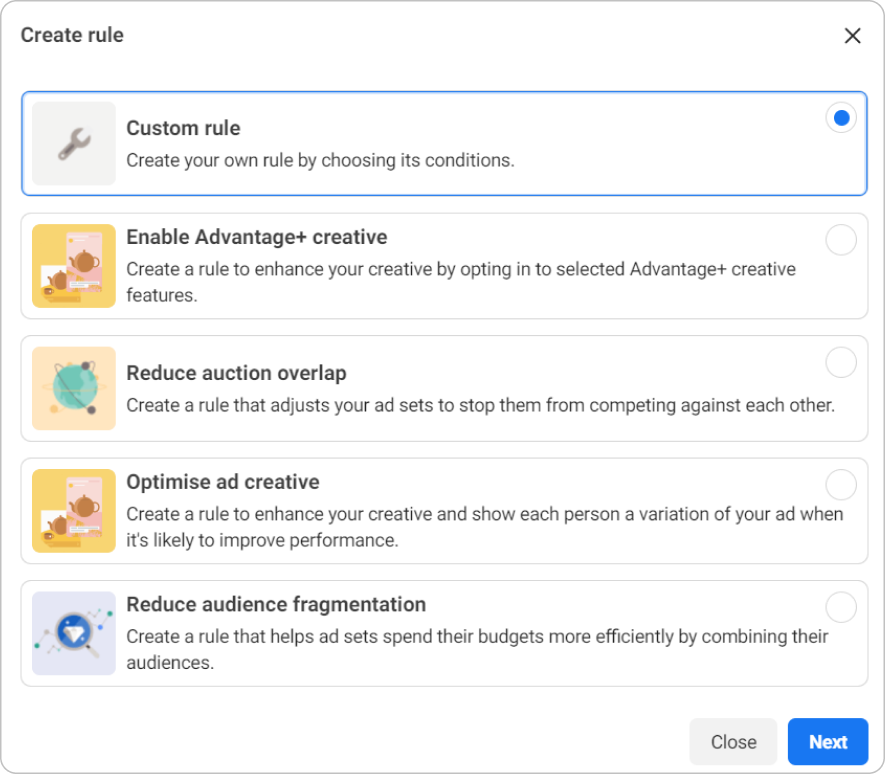
Facebook Ads Manager lets you create basic types of automated rules to improve ad performance.
The best way to use this feature is through special Facebook ads automation tools like ConvertBomb – it’s a fantastic alternative to Facebook’s native automated rules. It offers more options and is more customizable: you can set different types of rules to automate your Facebook ads the way you want and need.
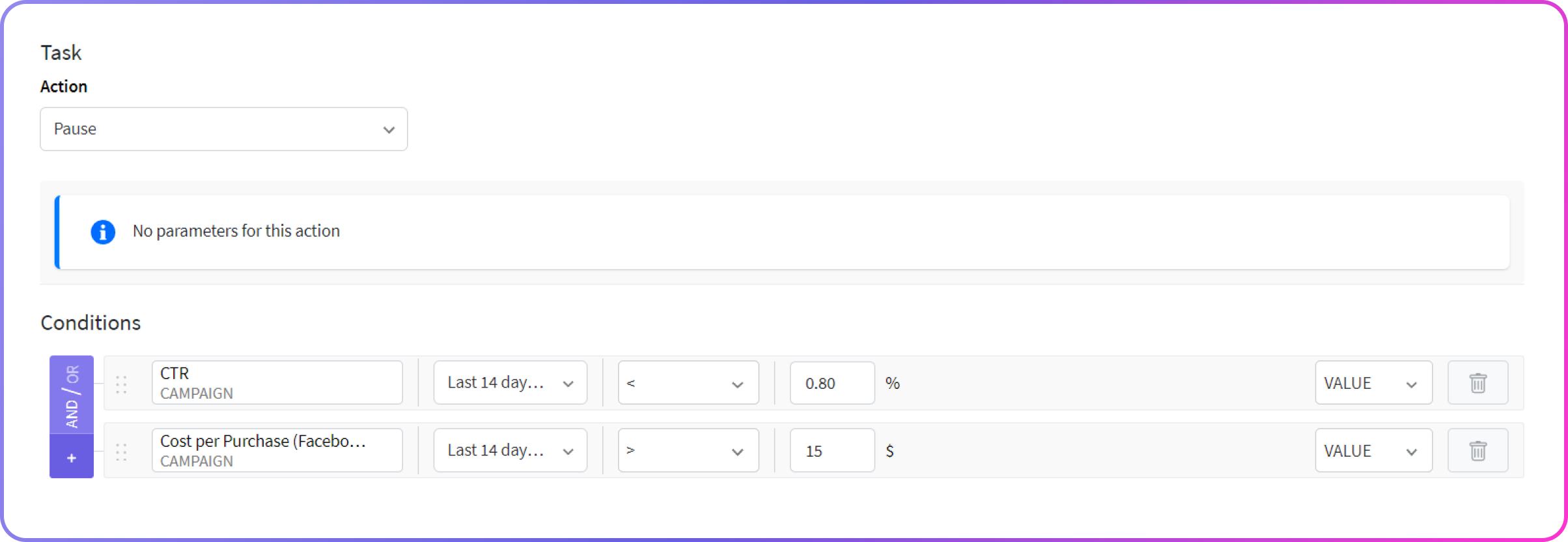 With ConvertBomb, you can automatically optimize your Facebook ads based on various goals and metrics.
With ConvertBomb, you can automatically optimize your Facebook ads based on various goals and metrics.
With ConvertBomb, your Facebook ads management becomes simpler and more straightforward. It’s a smarter way to maximize results while minimizing effort. Here are some simple ways to put this tool to work:
- Pause low-performing campaigns that don’t meet your standards, like a CTR under 0.8% or a Cost Per Conversion over $15. This will stop budget drain fast.
- Reward high-performing ad sets by automatically increasing their budget by 20% if they achieve a ROAS of 4x or better for three days straight.
- Use dynamic adjustments to scale budgets up or down – increase by 15% when ROAS consistently exceeds 3.5, or trim by 10% if it dips below 2.0.
- Pause ads with a high frequency above 4 and engagement rates dropping below 1% to make sure you’re not overloading your audience.
- Adjust your ad delivery to show during peak hours based on when your audience is most active.
If you’re ready to take your Facebook ads to a new level of performance in 2025, sign up for ConvertBomb’s free trial today and start exploring the benefits of ad automation.
For more tips and tricks, check out our articles on how to use Facebook ad automation strategies and reduce high Facebook ad costs.
Recap
If you want to start the new year strong and optimize your Facebook ads, follow this simple algorithm: analyze, set the right goals, refresh your ads and audiences, test, automate, rinse, and repeat. That’s how you set yourself up for success in 2025 and make the most of every campaign.

